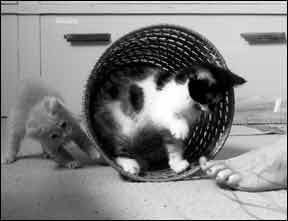Few things in life are sweeter than the sight of a newborn kitten, nursing contentedly at its mother’s nipple. A healthy kitten will nurse every 20 minutes or so, typically for about eight weeks, during which time its mother’s milk will fulfill all of the kitten’s nutritional needs.

288
Unfortunately, that milk can also contain the larvae of intestinal worms — parasitic creatures that can compromise a kitten’s health and, if nothing is done to stem their proliferation, may lead to life-threatening illness.
For this reason, the Companion Animal Parasite Council (CAPC), the American Association of Veterinary Parasitologists (AAVP) and other organizations strongly recommend that all newborn kittens be tested for these worms and be given medications that will kill the parasites — a process called “deworming” — on a routine schedule beginning when they are three weeks old.
Intrusive Creatures. A parasite is an organism that inhabits and finds its nourishment inside another creature, contributing nothing beneficial to its host’s well-being, and often robbing the infected animal of valuable nutrients or otherwise damaging its health. Cats commonly serve as hosts for these organisms.
Among the most troublesome of feline parasites are certain helminths, worms that inhabit the feline gastrointestinal tract — the stomach and intestines.
According to Dwight Bowman, DVM, PhD, a professor of microbiology and immunology at Cornell University’s College of Veterinary Medicine, the two helminths most frequently found in cats are roundworms and hookworms. Both are classified as nematodes — worms with distinctively cylindrical, unsegmented bodies that are narrowed at each end.
One type of roundworm — Toxocara cati — is especially common, says Dr. Bowman. It is known to thrive everywhere in the U.S., and can survive in any climate, although, he notes, it tends to do less well in very hot, dry regions. Mature roundworms are not a pretty sight, the typical adult being a white, spaghetti-like creature about three to five inches long.
In most cases of roundworm infection, a cat will harbor dormant larvae in its body for years, possibly throughout its life, without harmful consequences. But if enough of the larvae develop into mature worms and enter the gastrointestinal system, serious vomiting and diarrhea can result. And if 40 or 50 adult worms collect in the intestine, they can create a potentially life-threatening blockage. Roundworm infection is especially dangerous for kittens and for elderly cats with other health problems, notes Dr. Bowman.
Depending on the species of roundworm, cats can become infected in three different ways: by ingestion of eggs passed in the stool of an infected cat, by eating a rodent that harbors roundworm larvae or by ingesting worm larvae that are present in the milk of an infected queen. Although the larvae in the mother cat may be dormant, they become active during pregnancy, migrate to the mammary glands and subsequently invade the mother’s milk. This transmammary route is common, and explains why kittens account for the vast majority of felines at risk for serious worm-caused illness.
Another common threat to kittens — whose bodies and immune systems are less well developed than those of adult cats — is hookworm infection. These creatures cause blood to leak from the intestinal lining into the small bowel of the host; if not treated promptly, the resulting blood loss can lead to life-threatening anemia.
There are several ways in which an uninfected cat can get hookworm parasites into its body: by ingesting the worms’ larvae in soil or on vegetation that has been contaminated by an infected cat’s feces, by larvae penetrating its skin or by eating the tissue of a prey animal — such as a mouse — in which larval worms can persist in a dormant phase.
Signs of Infection. A cat’s physical reaction to the presence of roundworms in its system is often not apparent. In fact, says Dr. Bowman, most owners of adult cats won’t know their cats are infected until they are hosting large numbers of fully grown worms. “But that’s not to say that a problem doesn’t exist,” he notes. “No one would like to have five-inch-long worms swimming around in their intestines.”
A cat that is experiencing advanced roundworm infection may develop serious diarrhea, a natural process for ridding the intestines of the irritating worms. Or an animal may have frequent bouts of vomiting and weight loss; this process can be futile, however, since many of the regurgitated worms are apt to be swallowed and, thus, to regain entry into the digestive system. The most severe health threat is an impacted intestinal tract — caused by the sheer physical mass of harbored roundworms — and the possibility that, as the worms move about, they might cause a perforation of the bowel wall, which can lead to lethal infection or hemorrhage.
The clinical signs of acute hookworm infection are different. The most telling among them is the presence of black, tarry, perhaps bloody feces. In chronic cases, the blood is lost at a slower rate, and no obvious signs of infection may be present, but the cat will nevertheless be anemic.
Kittens are especially vulnerable if infected with either of these parasites, Dr. Bowman notes. “They’re smaller and their tissues are thinner,” he says.
Diagnosis and Treatment. To test for the presence of roundworm or hookworm infection, a veterinarian will do a fecal flotation test in which a stool sample taken from an animal is mixed in a cylinder with a special solution that causes any eggs that are present in the liquid to float upward and collect on a microscope slide placed on top of the cylinder. A microscopic study of the liquid will then identify the culprit.
According to Dr. Bowman, there are numerous medications available that are both safe and effective in preventing — and getting rid of — roundworms and hookworms. All of the deworming drugs can be administered by a cat’s owner, he notes. The frequency with which a cat should be dewormed will be determined by a veterinarian and will depend largely on an animal’s age, the apparent severity of worm infection and the animal’s general health.
Noting that roundworm and hookworm infection should be suspected in all young cats, however, Dr. Bowman recommends fecal examination — and deworming if needed — as a standard component of any kitten’s earliest health care. “I would like to see all veterinarians routinely conduct fecal examinations and, when appropriate, use these medications,” he says. Following are the recommendations for feline deworming that are currently promoted by CAPC and AAVP:
Every kitten should be tested and dewormed starting at three weeks of age. The deworming should be repeated at eight and 10 weeks and monthly thereafter until the animal is six months of age, after which it should be dewormed on an adult schedule.
– All adult cats should be tested and dewormed routinely (every three months or so).
– Females should be dewormed prior to nursing and at birthing.
– Nursing queens should be tested and dewormed according to the same schedule as that of their offspring.
– All newly acquired cats should be dewormed immediately — beginning no later than two weeks after adoption.



